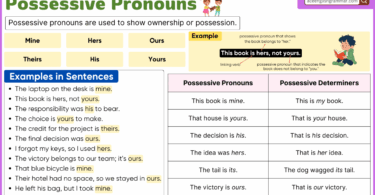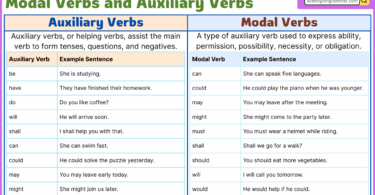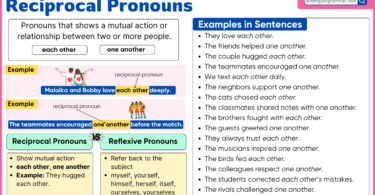A gerund is the -ing form of a verb that functions as a noun in a sentence. It looks like a verb but acts like a name of an action. Gerunds help express activities, habits, or ideas clearly and are used as subjects, objects, or complements. In this blog post, you’ll learn what gerunds are, how they’re formed, and where to use them in real grammar situations.
Table of Contents
What is a Gerund?
A gerund is the -ing form of a verb that works as a noun in a sentence. It names an action or activity and can be used as a subject, object, or complement.
Examples
- His hobby is painting. (Complement)
- Swimming is good for health. (Subject)
- She enjoys reading. (Object)
Formation of Gerunds
- Add -ing to regular verbs: Walk → Walking
- Drop -e from verbs ending in -e: Dance → Dancing
- Double the final consonant in one-syllable verbs with a single vowel + consonant: Run → Running
- Memorize irregular verb forms: Go → Going
- Maintain -ing for verbs ending in -ee: See → Seeing.
- Change -ie to -y and add –ing: Die → Dying
Gerunds vs Infinitives
| Aspect | Gerund (-ing) | Infinitive (to + base verb) |
|---|---|---|
| Acts As | Noun | Noun, Adjective, Adverb |
| Common Use | General activity or idea | Purpose, intention, future action |
| Examples | She likes dancing. | She likes to dance. |
| Tone | More casual, general | Slightly more formal or intentional |
Gerund vs Participle
A gerund is the -ing form of a verb that acts as a noun → Swimming is fun.
- Gerund → noun
A participle is a verb form that acts as an adjective or forms part of a verb tense. It can end in -ing, -ed, or -en → The painted wall looked fresh. → She has eaten.
- Participle → adjective or verb helper
Types of Gerunds in English Grammar
Gerunds are -ing verb forms that act as nouns. They appear in different roles depending on their placement in a sentence.
1. Subject Gerund
Used as the main subject of a sentence.
- Swimming is good for health.
2. Object Gerund
Used as the object after a verb.
- She enjoys reading.
3. Possessive Gerund
Shows who performs the action using a possessive.
- I liked her singing.
4. Gerund After Preposition
Follows a preposition to complete the phrase.
- He’s interested in learning.
5. Gerund as Object Complement
Adds information about the object or its result.
- She found the movie boring.
6. Gerund in Compound Nouns
Used in a noun phrase to show purpose.
- They cleaned the washing machine.
7. Gerund in Infinitive Phrases
Appears in an infinitive structure for detailed meaning.
- She decided to go jogging.
Gerund phrases
Gerund phrases are phrases that include a gerund (a verb form ending in “-ing”) along with other words that modify or complement it. There are several types of complements that can be associated with gerund phrases, including direct objects, indirect objects, and prepositional phrases. Here are some examples of gerund phrases:
Examples:
- Exercising regularly is essential for good health.
- She enjoys reading historical novels.
- The most enjoyable thing is spending time with friends.
- She apologized for interrupting the meeting.
- I like watching movies in my free time.
- We are looking forward to meeting you.
Examples Sentences of Gerund
- I enjoy reading
- She likes playing with friends.
- She hates cleaning the house.
- We started working on the project.
- He finished reading the book.
- They kept practicing.
- Painting is a form of self-expression.
- We should avoid making
- I recommend watching that movie.
- She considers the movie worth watching.
- We practice speaking English every day.
- I can’t help laughing.
- She avoids eating junk food.
- Gardening is my favorite hobby.
- I regret not studying harder for the exam.
- She apologized for making a mistake.
List of Words Followed by Gerunds
- Enjoy
- Like
- Love
- Hate
- Start
- Finish
- Admit
- Avoid
- Consider
- Advice
- Imagine
- Suggest
- Appreciate
- Recommend
- Miss
- Delay
- Practice
- Acknowledge
- Can’t help
- Mind
- Stop
- Keep
- Continue
- Begin
- Dislike
- Forgive
- Celebrate
- Discuss
- Prevent
- Risk
- Deny
- Resist
- Regret
- Defer
- Urge
- Try
- Quit
FAQs
Q1: What is a gerund?
A gerund is a verb form ending in “-ing” that functions as a noun in a sentence.
Q2: How do you form a gerund?
To form a gerund, add “-ing” to the base form of a verb, such as “running,” “swimming,” or “eating.”
Q3: What is the difference between a gerund and a present participle?
Both gerunds and present participles end in “-ing,” but gerunds function as nouns, while present participles are part of verb tenses (He is running. uses “running” as a present participle).
Q4: How do I distinguish between gerunds and participles in a sentence?
Look at the function of the word in the sentence. If it acts as a noun, it’s a gerund; if it modifies a noun or is part of a verb tense, it’s a participle.
Q5: Give some examples of gerunds.
- Swimming is great exercise (subject)
- I enjoy reading books (direct object)
- She’s interested in cooking (object of a preposition)
- His favorite activity is hiking (complement of a verb)
- I can’t help laughing at his jokes. (can’t help
Read More




Leave a Comment